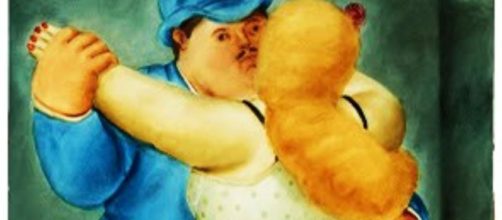You’d know him anywhere. He’s one of those artists whose paintings are instantly recognizable. The figures that Fernando Botero pictures come in only one size – extra-large. Slighted by the art world, he was popular with the public, selling his art between $1 million to $5 million. He died last month at age 91.
Come Dec. 7, two of his paintings go on the auction block in Los Angeles – “Couple Dancing” and “Nude Figure Reclining” – both show Botero’s signature style of inflated figures.
The dissing of Botero’s work among aficionados shows up even when praised.
Pablo Helguera, former director of educational programs at MoMA, wrote in an obituary for the L.A. Times: “Botero made meaningful art.” Imagine feeling the need to point that out!
When size doesn’t matter
Not that every art expert disparaged Botero. L.A. Museum curator Dorothy Miller told Helguera that even though the artist “went against the grain of the then-reigning Abstract Expressionist movement,” she acquired his work for the L.A. Museum anyway:
“I saw in him a painter who pursued figuration in a new way... Once he settled into that form of working, he never wavered from it, sticking to it for the rest of his life.” Helguera faulted that habit, saying that “artists who never waver in style are looked down upon by the art world’s intelligentsia.”
Odd.
I would think that artists who flit from one style to another in order to fit the style of the day are the ones hard to take seriously. What of Peter Paul Ruben who so consistently pictured plump female figures that they became a descriptive term for full-figured women to this day – Rubenesque?
And what of the many artists in the 20th century who not only bucked Abstract Expressionism, but also never wavered in their artmaking style and nevertheless enjoyed praised from the art world?
Lucien Freud, for one, specialized in figurative art with a thick, impasto style that is so distinct, you’d know his paintings work without seeing his signature. He worked contemporaneously defying the vaunted Abstract Expressionist canon of the day and yet is deemed one of the preeminent English artists of the 20th century.
Marketing strategy?
Despite all that, Helguera believes that an artist using a consistent style is “too easy, formulaic and predictable.” He even went so far as to says that Botero’s consistency was a strategy – “to appeal to the market.”
Helguera found backing from former MoMA curator Robert Storr who told him. “Botero is the purest example of how an instantly recognizable style’ can defeat a gifted and wide-ranging artist.” His work, Storr contended, “became oppressively cute, self-contradicting, and impossible to take seriously. Thus, his trademark became his downfall.”
Helguera not only agree, but also said: “Had he been my classmate, my painting teachers would have probably flunked him.”
But wait, as if to save himself from push back for his classmate remark, Helguera ended by asking: “Is our rejection of Botero indicative of our own elitism?” Didn’t he answer that question when he said: “artists who never waver in style are looked down upon by the art world’s intelligentsia”?
,


